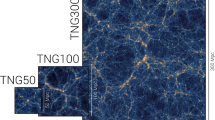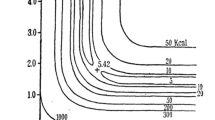Abstract
Using pseudo-time-dependent models and three different reaction networks, a detailed study of the dominant reaction pathways for the formation of cyanopolyynes and their abundances in TMC-1 is presented. The analysis of the chemical reactions show that for the formation of cyanopolyynes there are two major chemical regimes. First, early times of less than ∼104 yrs when ion-molecule reactions are dominant, the main chemical route for the formation of larger cyanopolyynes is
wheren=5, 7, and 9. Second, at times greater than 104 yrs, when neutral-neutral reactions become dominant, two major reaction routes for the formation of cyanopolyynes are (a),
and (b)
depending on the reaction network used. The results indicate that for route (a) large abundances ofC 2 H (fractional abundances of ∼10−7), and for route (b) large abundances ofC 2 H 2 are required in order to reproduce the observed abundances of cyanopolyynes. The calculated abundances of cyanopolyynes show great sensitivity to the value of extinction particularly att≳5×105 yrs (i.e. photochemical timescale). The effect of other physical parameters, such as the cosmic-ray ionization abundances are also examined. In general, the model calculations show that the observed abundances of cyanopolyynes can be achieved by pseudo-time-dependent models at late times of several million years.
Similar content being viewed by others
References
Bettens, R.P.A., Lee, H.H. and Herbst, E.: 1995, ‘The importance of classes of neutral-neutral reactions in the production of complex interstellar molecules’,Astrophys. J. 443, 664–674.
Draine, B.T.: 1978, ‘Photoelectric heating of interstellar gas’,Astrophys. J. Suppl. Ser. 36, 595–619.
Freeman, A. and Millar, T.J.: 1983, ‘Formation of complex molecules in TMC-1’,Nature 301, 402–404.
Gredel, R.: 1990, Cosmic Ray Induced Photodissociation and Photoionization of Interstellar Molecules’, in: T.W. Hartquist (ed.), Molecular Astrophysics — A Volume Honouring Alexander Dalgarno’, Cambridge University Press, 305–312.
Herbst, E.: 1983, ‘Ion-molecule synthesis of interstellar molecular hydrocarbons throughC 4 H —toward molecular complexity’,Astrophys. J. Suppl. Ser. 53, 41–53.
Herbst, E. and Leung, C.M.: 1990, ‘The gas-phase production ofCH 2 CN and other organonitrogen species in dense interstellar clouds’,Astron. Astrophys. 233, 177–180.
Herbst, E., Lee, H., Howe, D.A. and Millar, T.J.: 1994, ‘The effect of rapid neutral-neutral reactions on chemical models of dense interstellar clouds’,Mon. Not. R. Astron. Soc. 268, 335–344.
Hirahara, Y., Suzuki, H., Yamamoto, S., Kawaguchi, K., Kaifu, N., Ohishi, M., Takano, S., Ishikawa, S. and Masuda, A.: 1992, ‘Mapping observations of sulfur-containing carbon-chain molecules in Taurus Molecular Cloud 1 (TMC-1)’,Astrophys. J. 394, 539–551.
Howe, D.A. and Millar, T.J.: 1990, ‘The formation of carbon chain molecules in IRC+10216’,Mon. Not. R. Astron. Soc. 244, 444–449.
Irvine, W.M., Goldsmith, P.F. and Hjalmarson, Å.: 1987, Chemical Abundances in Molecular Clouds, in: D.J. Hollenbach and H.A. Thronson, Jr. (eds.), ‘Interstellar Processes’, Reidel, 561–609.
Irvine, W.M., Ohishi, M. and Kaifu, N.: 1991, ‘Chemical abundances in cold, dark interstellar clouds’,ICARUS 91, 2–6.
Kawaguchi, K., Kasai, Y., Ishikawa, S.-I. and Ohishi, M.: 1994, ‘Detection of a new molecular ionHC 3 NH + in TMC-1’,Astrophys. J. 420, L95-L97.
Langer, W.D., Velusamy, T., Kuiper, T.B.H., Levin, S. and Olsen, E.: 1995, ‘Study of structure and small-scale fragmentation in TMC-1’,Astrophys. J. 453, 293–407.
Millar, T.J., Rawlings, J.M.C., Bennett, A., Brown, P.D. and Charnley, S.B.: 1991, ‘Gas phase reactions and rate coefficients for use in astrochemistry. The UMIST ratefile’,Astron. Astrophys. Suppl. Ser. 87, 585–619.
Minh, Y.C., Dickens, J.E., Irvine, W.M. and McGonagle, D.: 1995, ‘Measurements of theH 132 CO ortho/para ratio in cold dark molecular clouds’,Astron. Astrophys. 298, 213–218.
Nejad, L.A.M. and Hartquist, T.W.: 1994, ‘Chemical diagnostics of magnetized boundary layers’,Astrophys. Space Sci. 220, 253–260.
Nejad, L.A.M., Hartquist, T.W. and Williams, D.A.: 1994, ‘Models of dense cores in translucent regions of low mass star formation’,Astrophys. Space Sci. 220, 261–278.
Ohishi, M., Irvine, W.M. and Kaifu, N.: 1992, Molecular Abundance Variations Among and Within Cold Dark Molecular Clouds, in P.D. Singh (ed.), ‘Astrochemistry of Cosmic Phenomena’, Kluwer, 171–177.
Ohishi, M., McGonagle, D., Irvine, W.M., Yamamoto, S. and Saito, S.: 1994, ‘Detection of a new interstellar molecule,H 2 CN’,Astrophys. J. 427, L51-L54.
Olano, C.A., Walmsley, C.M. and Wilson, T.L.: 1988, ‘The relative distribution ofNH 3,HC 7 N andCH 4 in the Taurus Molecular Cloud 1 (TMC 1)’,Astron. Astrophys. 196, 194–200.
Schiff, H.I. and Bohme, D.K.: 1979, ‘An ion-molecule scheme for the synthesis of hydrocarbon-chain and organonitrogen molecules in dense interstellar clouds’,Astrophys. J. 232, 740–746.
Schilke, P., Keene, J., Le Bourlot, J., Pineau des Forêts, G. and Roueff, E.: 1985, ‘Atomic carbon in a dark cloud: TMC-1’,Astron. Astrophys. 294, L17-L20.
Snell, R.L., Schloerb, F.P. and Young, J.S.: 1981, ‘Observations ofHC 3 N,HC 5 N andHC 7 N in molecular clouds’,Astrophys. J. 244, 45–53.
Winstanley, N. and nejad, L.A.M.: 1977, ‘In preparation’.
Author information
Authors and Affiliations
Rights and permissions
About this article
Cite this article
Winstanley, N., Nejad, L.A.M. Cyanopolyyne chemistry in TMC-1. Astrophys Space Sci 240, 13–37 (1996). https://doi.org/10.1007/BF00640193
Received:
Accepted:
Issue Date:
DOI: https://doi.org/10.1007/BF00640193




